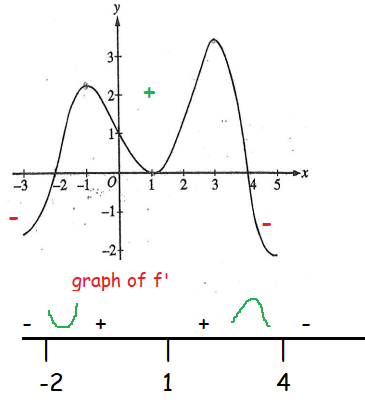HOW TO FIND RELATIVE MAXIMUM AND MINIMUM FROM DERIVATIVE GRAPH
Problem 1 :

The graph of the derivative of a function f is shown in the figure above. The graph has horizontal tangent lines at x = -1, x = 1 and x = 3. At which of the following values of x does f have relative maximum ?
A) -2 only B) 1 only C) 4 only D) -1 and 3 only
E) -2, 1 and 4.
Solution :
From the graph f'(x), x-intercepts of derivative functions are critical numbers of the original function f(x).
Analyzing the graph of f'(x) :
- Before -2, the curve is below the x-axis. So, in the interval (-∞, -2) f(x) will be decreasing then f(x) will have negative slope.
- After -2 upto 4, the curve is above the x-axis. So, in the interval (-2, 4) f(x) will be increasing then f(x) will have positive slope.
- After 4, the curve is below the x-axis. So, in the interval (4, ∞) f(x) will be decreasing then f(x) will have negative slope.

So, maximum value is at x = 4. Option C is correct.
Problem 2 :
The graph of f', the derivative of the function f is shown above for -3 ≤ x ≤ 3. On what intervals is f increasing ?
A) [-3, -1] only B) [-1, 3] C) [-2, 0] and [2, 3]
D) [-3, -1] and [1, 3]

Solution :
x-intercepts of f'(x) = critical numbers of f(x)
Critical numbers of f(x) :
-3, -1 and 2
Analyzing the graph of f'(x) :
- In between -3 to -1, the curve is below the x-axis. So, in the interval (-3, -1) the function f(x) will be decreasing and f(x) will have negative slope.
- In between -1 and 3, the the curve is above the x-axis. So, in the interval (-1, 3) the function f(x) will be increasing and f(x) will have positive slope.

In the interval [-1, 3], the function is increasing.
Problem 3 :

The graph of f', the derivative of f is shown above. The function f has local maximum at x = ?
A) -3 B) -1 C) 1 D) 3 E) 4
Solution :
f'(x) = 0, when x = -3 and x = 1
- These are critical points, to the left of -3, the graph is below the x-axis. So, it is decreasing.
- After -3 upto 1 it is above the x-axis. So, it is increasing.
- After 1, it is below the x-axis. So, it is decreasing.
Decreasing --> increasing --> decreasing
The, local maximum is at x = 1.
Problem 4 :
The graph of the derivative, f' of a function f is shown.
(a) On what interval(s) is f increasing or decreasing? Justify your answer.
(b) At what value(s) of x does f have a local maximum or local minimum? Justify your answer.

Solution :
x-intercepts of the derivative function shown above are 0 and 3. These two are critical numbers of f(x).
- In the interval (-∞, 0), f'(x) is above the x-axis. So, the function f(x) will have positive slope. Increasing function in the interval (-∞, 0).
- In the interval (0, 3), f'(x) is below the x-axis. So, the function f(x) will have negative slope. Decreasing function in the interval (0, 3).
- In the interval (3, ∞), f'(x) is above the x-axis. So, the function f(x) will have positive slope. Increasing function in the interval (3, ∞).
|
(-∞, 0) + |
(0, 3) - |
(3, ∞) + |
Increasing function ----> Decreasing function
At x = 0, the function f(x) has relative maximum.
Decreasing function ----> Increasing function
At x = 3, the function f(x) has relative minimum.
Problem 8 :

Solution :
x-intercepts of the derivative function shown above are -1, 3 and 5. These are critical numbers of f(x).
- In the interval (-∞, -1), f'(x) is below the x-axis. So, the function f(x) will have negative slope. Decreasing function in the interval (-∞, -1).
- In the interval (-1, 3), f'(x) is above the x-axis. So, the function f(x) will have positive slope. Increasing function in the interval (-1, 3).
- In the interval (3, 5), f'(x) is below the x-axis. So, the function f(x) will have negative slope. Decreasing function in the interval (3, 5).
- In the interval (5, ∞), f'(x) is above the x-axis. So, the function f(x) will have positive slope. Increasing function in the interval (5, ∞).
|
(-∞, -1) - |
(-1, 3) + |
(3, 5) - |
(5, ∞) + |
Decreasing ----> Increasing
At x = -1 and 5, the function f(x) has relative minimum.
Increasing ----> Decreasing
At x = 3, the function f(x) has relative maximum.
Recent Articles
-
Finding Range of Values Inequality Problems
May 21, 24 08:51 PM
Finding Range of Values Inequality Problems -
Solving Two Step Inequality Word Problems
May 21, 24 08:51 AM
Solving Two Step Inequality Word Problems -
Exponential Function Context and Data Modeling
May 20, 24 10:45 PM
Exponential Function Context and Data Modeling